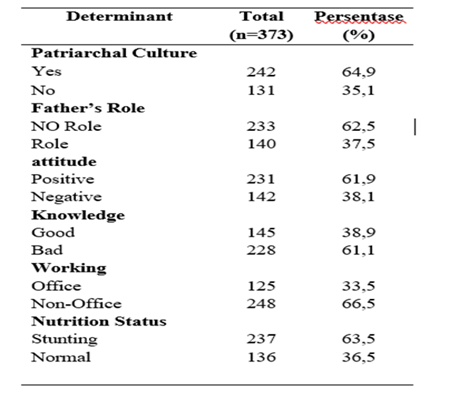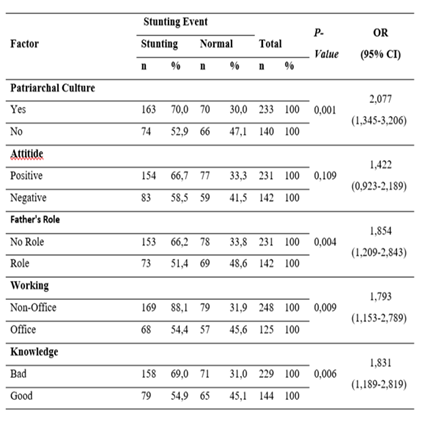The Relationship of Patriarchal Culture with Stunting Incidents in Toddlers 6-24 Months
In the frequency distribution of the questionnaire above, it can be seen that the distribution based on patriarchal culture can be said to be cultural. patriarchy in the Lamahalot community which has an impact on the incidence of stunting in toddlers. This is because men have a role as the main control in the household and society, while women have little influence or can be said to have no rights in general areas in society, both economically, socially, politically and psychologically, even including the institution of marriage. Every decision that is in the male household has a dominant role to decide until the decision to provide food intake to toddlers. Since the past, the culture of the people in Lamaholot (the race in East Flores) has placed men at the top of the hierarchy, while women have become the number two class. This can be seen in the practice of the Lamaholot community where women have to accompany their husbands/follow their husbands and take care of children, women are responsible for household work while men are responsible for subsistence work.
Patriarchal culture can be associated with the dominant role of a husband as a father in the household. The dominance of the father in providing positive input in the form of encouragement for his family members can be seen in the practice of giving food intake patterns to toddlers. Through support and reinforcement in influencing the growth and development of toddlers, which are based on patrilinealistic ties. This research is in line with research conducted [3]which states that, a father can provide positive support to improve breastfeeding practices, and maintain full support for his wife in breastfeeding until the baby is 6 months old to achieve exclusive breastfeeding. husbands can help their wives finish homework while their wives are breastfeeding, husbands can burp their babies after breastfeeding, help mothers breastfeed in public by removing nursing cloths, husbands can accompany their wives to come to lactation classes, provide adequate nutrition to mothers To facilitate breastfeeding, remind the wife to always give only breast milk until the baby is 6 months old.
The Relationship between Father's Attitude and Stunting Incidence in Toddlers 6-24 Months
In this study, attitude is the attitude of the father in the form of an assessment of the incidence of stunting in toddlers, where the father's behavior towards stunting toddlers in feeding children under five. It is known that in this study the father's attitude was positive towards the incidence of stunting. This illustrates that the behavior of fathers in affection for toddlers is quite good even though fathers rarely take care of their toddlers because fathers are busy at work.
The role of the father is no less important than the role of a mother who cares for and takes care of children at home because the role of the father is also important in shaping the growth and development of children such as emotional development in children. If a father gives full love to the child, the child will feel happy and comfortable when close to his father and it is better if a father does not give attention and affection to his child, the child will feel sad and uncomfortable when with his father. The attitude of the father that does not affect the nutritional status of toddlers is due to the most important factor affecting the nutritional status of toddlers, namely food with good nutrition. Foods with various nutrients are needed by toddlers for growth and development. Toddlers will grow optimally if their food intake is sufficient, nutritious, and balanced.
The father's positive attitude towards the incidence of stunting in toddlers is caused by the father feeling that the growth and development of toddlers is also his responsibility. That is, the potential for attitude reactions that have been formed in the individual will appear in the form of actual behavior as a reflection of the actual attitude towards something. Conversely, if the individual experiences or feels obstacles that can interfere with his freedom in expressing his true attitude or if the individual feels a physical threat or mental threat that can occur to him as a result of the attitude statement to be expressed, what is expressed by the individual as verbal behavior or action is very important. may not be in line with the attitude of his conscience, can even be very contrary to what he holds as a belief. The more complex the situation and the more factors that are considered in acting, the more difficult it is to predict behavior and the more difficult it is to interpret it as an indicator.
The Relationship of Father's Role with Stunting Incidence in Toddlers 6-24 Months
This research shows that there is a problem between the father's role and the incidence of stunting. This is because all affairs in nurturing, maintaining and providing food intake for toddlers are the responsibility of the woman/wife. This is a patriarchal view inherent in the Lamaholot community where the division of labor between men and women can be seen in the physical activities carried out. Where women in Lamaholot are responsible for household work while men tend to do nafka work. Fathers do not have a role in the incidence of stunting in toddlers, also because the father is often outside the house because of his father's occupation who is a fisherman and farmer. Domestic work is not valued as a job for purely economic reasons (work that makes money). The role of the father in the family not only affects changes in the socioeconomic status of the family but is also closely related to the involvement of the father in parenting.
Father involvement in parenting includes aspects of time, interaction, and attention to children. The involvement of fathers in parenting is not just a greater quantity of time for the child, but the quality of the interaction that is built is also fundamental. The role of a father in toddlers is no less important than a mother in fulfilling nutrition. Fathers work together to organize and control the family's expenses. Father involvement in parenting is father's continuous participation in child care which contains aspects of frequency, initiative and personal empowerment in the physical, emotional, social, intellectual and moral dimensions. This research is in line with research conducted [4]which states that the test results show that father's involvement in parenting has a significant positive effect on the cognitive development of children aged 2-3 years in stunting prevalence areas.
This finding is in line with previous research which also found that father involvement in parenting has a significant effect on children's cognitive fishermen and farmers, where father is always at work and has little time with his wife and children. Time spent with children is the most important factor in shaping a child's development and human capital[5]. In the father's work in this study, the researcher did not discuss and look at the income generated, but the researcher wanted to highlight the time fathers with their children because the majority of respondents in this study were fishermen (dominantly) and farmers where they spent more time at sea and in the fields. In previous studies, it was found that there was no relationship between economic status and the incidence of stunting in the people of East Flores (2020). That is, how the time that fathers spend in forming children and differences in the use of time between fathers for child development greatly contribute to inequality in the quality of children in the future. Some views from the Lamaholot community if the father spends too much time for the child, the father will experience anopportunity cost. People often experience a dilemma whether the father chooses to use his time to work and make money or prefer to use his time to take care of the child where the father does not increase income, but on the other hand the future growth of their children is improving. In other words, when the father is with the child, it plays an important role in the child's growth because the wife can prepare and provide good complementary foods according to government recommendations. The high number of hours worked does have a positive impact on the Indonesian economy.
However, the effect of increasing the number of hours worked on children's development is still unknown. It is feared that the high number of working hours will reduce the interaction time between parents and children where the interaction of parents and children is an important input in building child development[6]. Child development is closely related to the investment given by parents, including the time that parents give to their children. Ideally, the more time parents give to their children, the more stimulation they will get so that the child's development becomes optimal. Some studies have found that working hours have a positive impact on children's cognitive development, but there are also other studies that have found the opposite result[6]. Based on several studies conducted[7,8] found a positive impact of the number of hours worked on children's cognitive development.[7,8].
The Relationship of Father's Knowledge with Stunting Incidence in Toddlers 6-24 Months
Father's knowledge is still low about parenting in toddlers resulting in the high incidence of stunting in East Flores. In research, father's knowledge greatly influences the incidence of stunting, fathers need to get good knowledge regarding parenting in toddlers because fathers also have responsibility for toddler development, not only mothers who get knowledge from health workers. With good knowledge, fathers will tend to care about child rearing patterns, according to the concept of L.Green's behavior, one of the things that affect one's health is one's knowledge and attitude. Knowledge certainly plays an important role, because by having good knowledge about parenting, fathers can decide what attitude can be done to overcome health problems in toddlers, especially reducing the risk of stunting in toddlers. Increased knowledge is not absolutely obtained from.
Formal education, but can also be obtained in non-formal education. Fathers can also get knowledge from cadres' mothers or health workers when accompanying or dropping their children to the Posyandu. A person's knowledge of an object also contains two aspects, namely positive and negative aspects. These two aspects will ultimately determine a person's attitude towards a particular object [9]. The more positive aspects of the object are known, the more positive attitude will be towards the object. This level of knowledge will later shape a person's attitude towards something. Attitude is not yet an action or activity, but it is still a predisposition to the action of a behavior. A person's attitude will affect health behavior, a person's positive attitude will produce positive health behavior as well [10]. This research is in line with research conducted[11]. Parental knowledge about stunting is still lacking, as shown from the results of this study, namely as many as 11 (55%) parents have less knowledge about stunting. Based on the bivariate test (table 6), it can be seen that the factors that are significantly related to knowledge about stunting.




